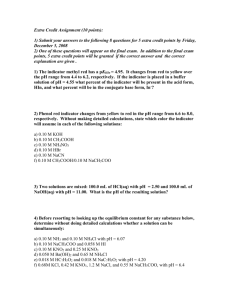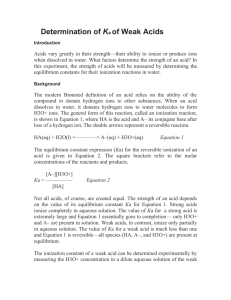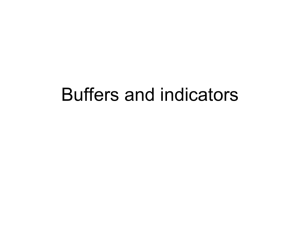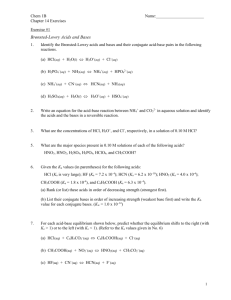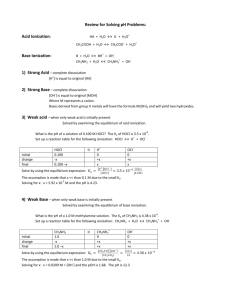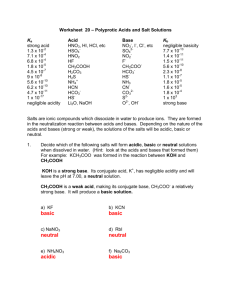CH3COOH + H2O CH 3COO
advertisement
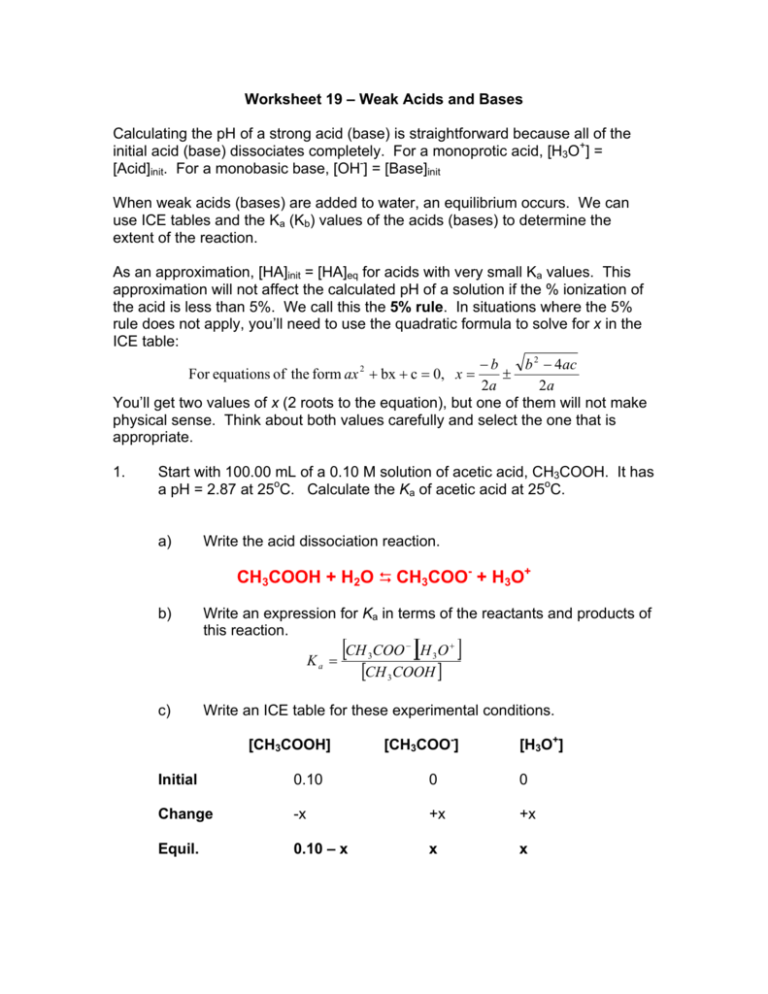
Worksheet 19 – Weak Acids and Bases Calculating the pH of a strong acid (base) is straightforward because all of the initial acid (base) dissociates completely. For a monoprotic acid, [H3O+] = [Acid]init. For a monobasic base, [OH-] = [Base]init When weak acids (bases) are added to water, an equilibrium occurs. We can use ICE tables and the Ka (Kb) values of the acids (bases) to determine the extent of the reaction. As an approximation, [HA]init = [HA]eq for acids with very small Ka values. This approximation will not affect the calculated pH of a solution if the % ionization of the acid is less than 5%. We call this the 5% rule. In situations where the 5% rule does not apply, you’ll need to use the quadratic formula to solve for x in the ICE table: −b b 2 − 4ac ± 2a 2a You’ll get two values of x (2 roots to the equation), but one of them will not make physical sense. Think about both values carefully and select the one that is appropriate. For equations of the form ax 2 + bx + c = 0, x = 1. Start with 100.00 mL of a 0.10 M solution of acetic acid, CH3COOH. It has a pH = 2.87 at 25oC. Calculate the Ka of acetic acid at 25oC. a) Write the acid dissociation reaction. CH3COOH + H2O ' CH3COO- + H3O+ b) Write an expression for Ka in terms of the reactants and products of this reaction. CH 3COO − H 3 O + Ka = [CH 3COOH ] [ c) ][ ] Write an ICE table for these experimental conditions. [CH3COOH] [CH3COO-] [H3O+] Initial 0.10 0 0 Change -x +x +x Equil. 0.10 – x x x d) Solve for [H3O+] with the information in your table and equations. Then, calculate the value for Ka. [ H 3O + ] = 10 − pH = 10 −2.87 = 1.35 × 10 −3 M = x Ka = [CH COO ][H O ] = (1.35 × 10 )(1.35 × 10 ) = 1.85 × 10 [CH COOH ] (9.865 × 10 ) − 3 + −3 −3 3 −5 −2 3 e) Calculate the % ionization for 0.10 M acetic acid. Is the 5% approximation O.K.? 1.35 × 10 −3 [H3O+]eq x 100% = × 100% = 1.35% 0.10 [CH3COOH]init ( ) This tells us that [CH3COOH]eq ≈ [CH3COOH]init because 1.35 % < 5%. We could write the [CH3COOH] at equilibrium in our ICE table simply as ~0.10, and it would not make a significant impact on pH or Ka f) Now, add 900.00 mL of water to this system (total volume is 1.00 L). Calculate the pH of a 0.010 M solution of acetic acid, using the same Ka. Initial [CH3COOH] 0.010 [CH3COO-] 0 [H3O+] 0 Change -x +x +x Equil. 0.010 – x x x x2 x2 ≈ 0.010 − x 0.010 = [ H 3O + ] K a = 1.85 × 10 −5 = x ≈ 4.30 × 10 − 4 pH = − log(4.30 × 10 − 4 ) = 3.37 g) Calculate the % ionization of this reaction. Is it larger or smaller than in the 0.10 M solution? Explain this in terms of Le Chatelier's Principle. (Hint: think about the effects of volume changes on gaseous systems) 4.30 × 10 −4 % ionization = × 100% = 4.30% 0.010 This is a larger dissociation, but still less than 5%, so the approximation that “0.010 – x = 0.010” was okay. We increased the solution volume, so the reaction shifted to the side that had more moles (not counting the water, which doesn’t appear in the equilibrium expression). We could also calculate Q to see that the reaction would shift to the right (towards the product side) ( ) 2. What is the pH of a 0.0010 M solution of methyl amine, CH3NH2, with a Kb = 4.4 x 10-4? (Does the 5% rule apply here?) Follow the same general steps that were used in problem #1, but consider how starting with a base will change the process We write the reaction of a base with water to product a conjugate acid and hydroxide: CH3NH2 + H2O ' CH3NH3+ + OH- Kb = Initial Change Equil. [CH ][ NH 3+ OH − [CH 3 NH 2 ] 3 ] [CH3NH2] [CH3NH3+] [OH-] 0.0010 -x 0.0010 – x 0 +x x 0 +x x K b = 4.4 × 10 − 4 = [CH ][ ] NH 3+ OH − x2 ≈ [CH 3 NH 2 ] 0.0010 3 x ≈ 6.6 × 10 − 4 % ionization = (6.6 × 10 ) × 100% = 66% −4 0.0010 The % ionization for this reaction is 66%, so the 5% rule definitely does NOT apply. We need to solve for the actual value of x (not an approximation) using the quadratic equation: K b = 4.4 × 10 − 4 = [CH ][ ] NH 3+ OH − x2 = [CH 3 NH 2 ] 0.0010 − x 3 4.4 × 10 − 4 (0.0010 − x ) = x 2 x 2 + 4.4 × 10 − 4 x − 4.4 × 10 −7 = 0 For equations of the form ax 2 + bx + c = 0, x = − 4.4 × 10 − 4 x= ± 2(1) (4.4 × 10 ) −4 2 x = 4.8 × 10 − 4 and x = −9.2 × 10 − 4 ( b 2 − 4ac −b ± 2a 2a − 4(1) − 4.4 × 10 −7 2(1) ) Equilibrium concentrations can never be less than 0, so we pick the first root, x = 4.8 x 10-4, and then solve for the pOH before calculating the pH. x = 4.8 × 10 −4 = [OH − ] pOH = − log(4.8 × 10 − 4 ) = 3.3 pH = 14 − 3.3 = 10.7 3. A 0.1 M solution of a monoprotic acid, HA, is 4.2 % ionized. What is the Ka? HA + H2O ' A- + H3O+ Initial [HA] 0.1 [A-] 0 [H3O+] 0 Change -x +x +x Equil. 0.1 – x x x % ionization = x × 100% = 4.2% 0.1 x = 4.2 × 10 −3 The 5% rule can be used here because the % ionization is less than 5%: [A ][H O ] = = − Ka + 3 [HA] ( 4.2 × 10 −3 x2 x2 ≈ ≈ 0.10 − x 0.10 0.10 ) 2 ≈ 1.76 × 10 − 4 How does the actual Ka value compare to the one determined using the 5% rule? ( ) 2 4.2 × 10 −3 x2 Ka = = = 1.84 × 10 − 4 0.10 − x 0.10 − 4.2 × 10 −3 Both values round to 1.8x10-4, so the approximation does not have a significant affect on the calculated Ka value.
